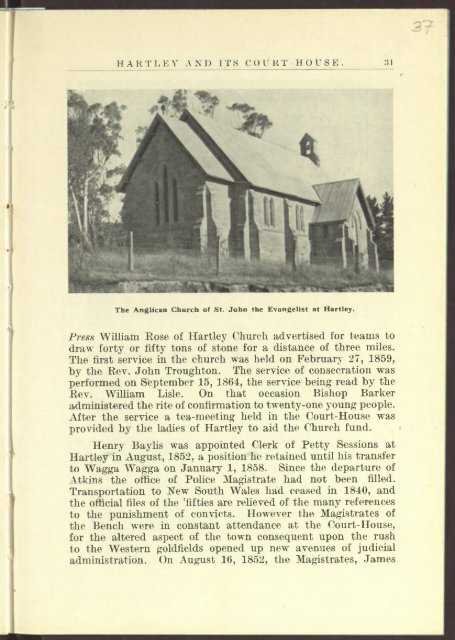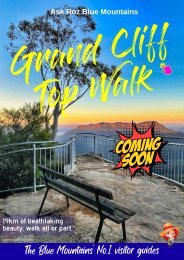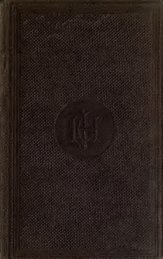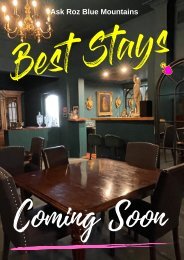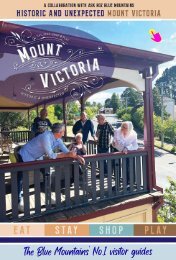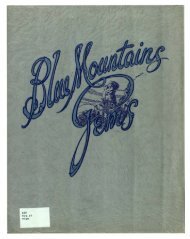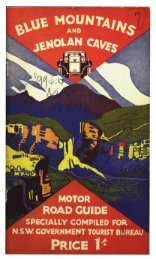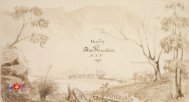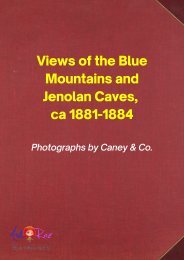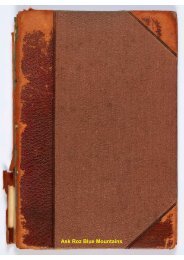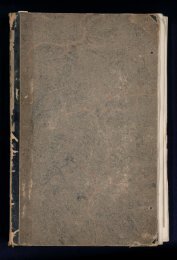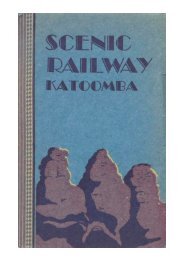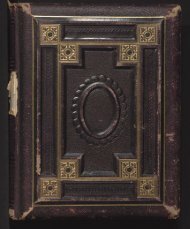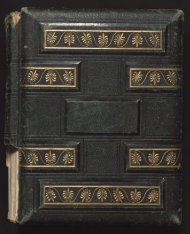Hartley Court House - 1837 to 1937
Hartley Court House - 1837 to 1937
Hartley Court House - 1837 to 1937
You also want an ePaper? Increase the reach of your titles
YUMPU automatically turns print PDFs into web optimized ePapers that Google loves.
-35<br />
HARTLEY AND ITS COURT-HOUSE. 29<br />
Roman Catholics formed a very large proportion of the local<br />
community and soon set about building up a fund for the<br />
erection of a church. The Eev. Michael Cavanagh was the<br />
priest at the time. B y Oc<strong>to</strong>ber, 1841, private contributions for<br />
this purpose amounted <strong>to</strong> £300. In February, 1842, the<br />
Government approved of an allowance of aid equal <strong>to</strong> the<br />
amount of private contributions not exceeding one thousand<br />
pounds. The site for the Roman Catholic Church opposite the<br />
<strong>Court</strong>-<strong>House</strong> was surveyed in 1842. In 1845 one acre was<br />
granted for a Rom an Catholic burial ground. A granite <strong>to</strong>r<br />
is conspicuous east across the gully from the church. According<br />
<strong>to</strong> Surveyor Liddell [1877] its name is Kew-y-ahn.<br />
G o v e r n o r a n d L a d y M a r y F i t z R o y V is i t H a r t l e y .<br />
Governor and Lady Mary FitzR oy visited the country<br />
districts in order <strong>to</strong> acquire a personal knowledge of the wants<br />
and capabilities of the part of the country visited. On November<br />
12, 1846, they paused with their suite at <strong>Hartley</strong> on their way<br />
<strong>to</strong> Bathurst. Lieutenant-Colonel Mundy, a member of the<br />
party, describing the landscape from the Pass of Vic<strong>to</strong>ria<br />
wrote : “ The valley on the left looked dark, desolate, and<br />
wholly uninhabited ; on the right lay the smiling Vale of<br />
Clywd and the little <strong>to</strong>wnship of <strong>Hartley</strong>, upon which the road<br />
drops as gently as could possibly be contrived by human art.<br />
“ Ere we reached this highland hamlet we came upon a<br />
considerable body of horsemen, who, saluting his Excellency<br />
with loud and hearty cheers, so as<strong>to</strong>nished our horses, if not<br />
ourselves, as nearly <strong>to</strong> drive the whole cavalcade over the<br />
precipice. In a cloud of dust, and with wild huzzas, they<br />
closed round us, and bore us away <strong>to</strong> the <strong>Court</strong>-house, where<br />
the usual duel of address and reply was instantly and warmly<br />
engaged in by the authorities of the place and the Governor.<br />
As we drove down the hill, with our loyal and uproarious escort<br />
galloping alongside, an individual spurring at my elbow suddenly<br />
disappeared, horse and man, over the edge of a rude bridge in<strong>to</strong><br />
a watercourse below. N ot one of his <strong>to</strong>wnsmen pulled up—<br />
no one even looked behind ; my servant however dropped from<br />
the carriage and ran <strong>to</strong> his assistance. The indifference of his<br />
companions was at once explained. He was only a negro !<br />
“ The <strong>Court</strong>-house and Catholic chapel of <strong>Hartley</strong> are<br />
prettily situated. My sketch was taken from a spot just<br />
beyond these objects.”


